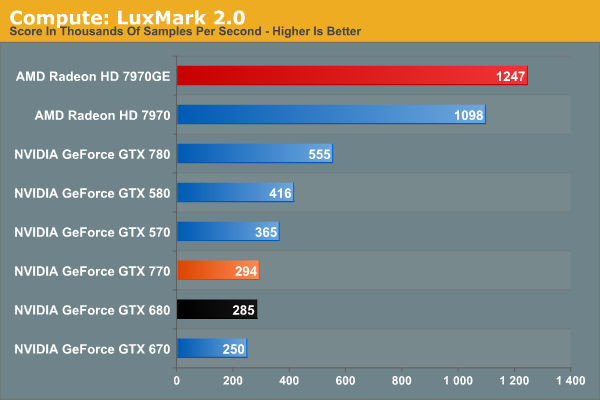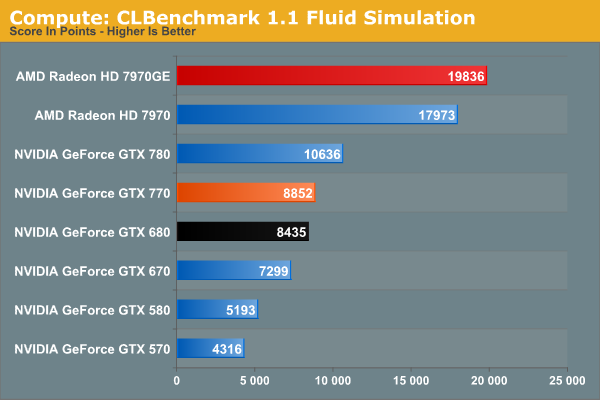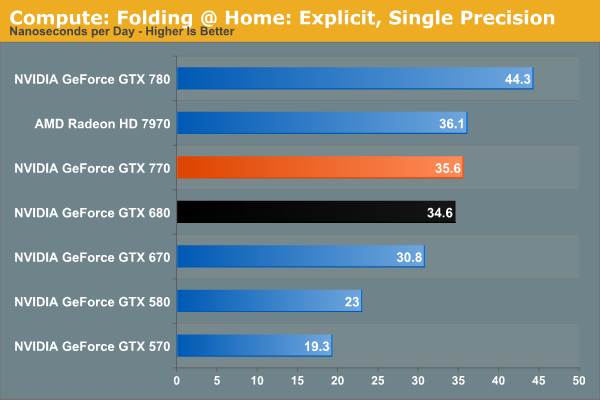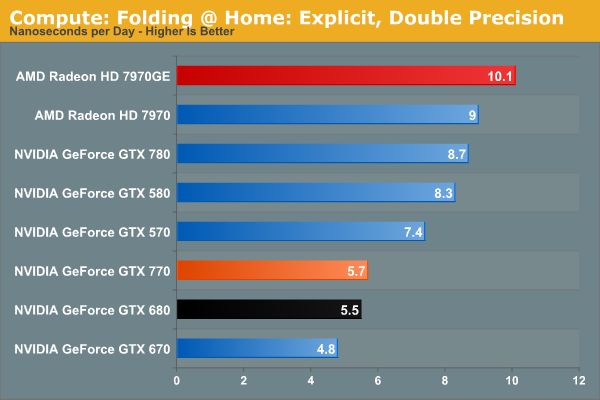NVIDIA GeForce GTX 770 Review: The $400 Fight
by Ryan Smith on May 30, 2013 9:00 AM ESTCompute
Jumping into compute, we aren’t expecting too much here. Outside of DirectCompute GK104 is generally a poor compute GPU, and other than the clockspeed boost GTX 770 doesn’t have much going for it.
As always we'll start with our DirectCompute game example, Civilization V, which uses DirectCompute to decompress textures on the fly. Civ V includes a sub-benchmark that exclusively tests the speed of their texture decompression algorithm by repeatedly decompressing the textures required for one of the game’s leader scenes. While DirectCompute is used in many games, this is one of the only games with a benchmark that can isolate the use of DirectCompute and its resulting performance.

Civilization V at least shows that NVIDIA’s DirectCompute performance is up to snuff in this case. Though as is the case with GTX 780, we’re reaching the limits of what this benchmark can do, due to just how fast modern cards have become.
Our next benchmark is LuxMark2.0, the official benchmark of SmallLuxGPU 2.0. SmallLuxGPU is an OpenCL accelerated ray tracer that is part of the larger LuxRender suite. Ray tracing has become a stronghold for GPUs in recent years as ray tracing maps well to GPU pipelines, allowing artists to render scenes much more quickly than with CPUs alone.

Moving on to a more general compute task, we get a reminder of how poor GK104 is here. GTX 770 can beat the slower GK104 products, and that’s it. Even GTX 570 is faster, never mind the massive lead that 7970GE holds.
Our 3rd benchmark set comes from CLBenchmark 1.1. CLBenchmark contains a number of subtests; we’re focusing on the most practical of them, the computer vision test and the fluid simulation test. The former being a useful proxy for computer imaging tasks where systems are required to parse images and identify features (e.g. humans), while fluid simulations are common in professional graphics work and games alike.


CLBenchmark paints GTX 770 in a better light than LuxMark, but not by a great deal. The gains over the GTX 680 are miniscule since these benchmarks aren’t memory bandwidth limited, and the gap between it and the 7970GE is nothing short of enormous.
Moving on, our 4th compute benchmark is FAHBench, the official Folding @ Home benchmark. Folding @ Home is the popular Stanford-backed research and distributed computing initiative that has work distributed to millions of volunteer computers over the internet, each of which is responsible for a tiny slice of a protein folding simulation. FAHBench can test both single precision and double precision floating point performance, with single precision being the most useful metric for most consumer cards due to their low double precision performance. Each precision has two modes, explicit and implicit, the difference being whether water atoms are included in the simulation, which adds quite a bit of work and overhead. This is another OpenCL test, as Folding @ Home has moved exclusively to OpenCL this year with FAHCore 17.


Recent core improvements in Folding @ Home continue to pay off for NVIDIA. In single precision the GTX 770 is just fast enough to hang with the 7970 vanilla, though the 7970GE is still over 10% faster. Double precision on the other hand is entirely in AMD’s favor thanks to GK104’s very poor FP64 performance.
Wrapping things up, our final compute benchmark is an in-house project developed by our very own Dr. Ian Cutress. SystemCompute is our first C++ AMP benchmark, utilizing Microsoft’s simple C++ extensions to allow the easy use of GPU computing in C++ programs. SystemCompute in turn is a collection of benchmarks for several different fundamental compute algorithms, as described in this previous article, with the final score represented in points. DirectCompute is the compute backend for C++ AMP on Windows, so this forms our other DirectCompute test.

Unlike our other compute benchmarks, System Compute is at least a little bit memory bandwidth sensitive, so GTX 770 pulls ahead of GTX 680 by 11%. Otherwise like every other compute benchmark, AMD’s cards fare far better here.










117 Comments
View All Comments
pandemonium - Friday, May 31, 2013 - link
Wait, you want to compare FPS/dollar and then turn around and say you choose which one has PhysX? Well, the marketing team certainly succeeded with you, lol.Apparently you don't know that PhysX is a software code path that is supported and available regardless of what hardware you run. There isn't an abundant pile of evidence, through benchmarking or otherwise, that having a Nvidia card while running a PhysX supported engine will yield superior results compared to a similarly priced AMD card. Example? Take Metro 2033; probably the more demanding DX11, PhysX supported engine games available: http://www.anandtech.com/bench/GPU12/377
inighthawki - Saturday, June 1, 2013 - link
PhysX is CUDA accelerated with an nvidia card present, and thus will have hardware accelerated physics (of course at the cost of some GPU processing that could otherwise be spent on rendering). There is a tradeoff. Personally I would prefer to just run it in software. When you buy something like a GTX 770 or 780, the GPU is typically the FPS bottleneck in your games :)SirGCal - Monday, June 10, 2013 - link
I really could care less about PhysX... And 60fps caps also give me migraines... I specifically build machines with 120fps+ caps... My current rig has a 144Hz cap. So smooth... Sure many people can't tell the different. Good for them. I get migraine headaches at 60 FPS with digital content. Including crappy movies which are even worse (~25 frames...). I have a very sensitive visual function of my body/mind. Actually a LOT of people do. That's why 3D movies really don't take off so well. Something like one in 10 can not actually see stereoscopic vision at all and only like one in three really enjoy our fake 3D effects... Something like that.But the extreme cases like myself, not only do I not enjoy it, but it causes actual physical pain. I buy the best to get 144fps, smooth as glass, all the time. And even doing so, I've never ever spent $4k on my gaming rig... heck, never spent more then $2k. So you're a bit sarcastic there. I guess if you don't build your own sure but... The real crappy part is avoiding the developers who refuse to open their crappy ports beyond 60Hz. There are some that leave the console locks in place on the PC. Those just never get purchased...
Mondozai - Monday, August 12, 2013 - link
Mention your migraines one more time, I'm sure we all missed it.firewall597 - Thursday, June 13, 2013 - link
Your one reason makes me lolololGastec - Sunday, July 7, 2013 - link
I for one choosed Nvidia over AMD because of the Radeon frame times problem. I would agree that not so many people buy a 4000$ computer in a shop, unless it's an Apple I guess :-P Though many so called computer enthusiasts do end up paying over time quite a hefty sum on hardware components and software. It's not because they are snobs wanting the best, but because the best costs so much money :)jonjonjonj - Tuesday, June 4, 2013 - link
its their 2nd best single gpu card not the 3rd. a multi gpu 690 is not comparable and amd also has a 7990 so that would make the 7970 the 2nd best card by your logic. i personally see it as a complete failure that their 2nd best card is equal to amds best card that came out 18 months ago. think about that the 7970 came out a year and a half ago. its nothing to brag about. before you call me a amd fan. i'm not i look for the best price/performance and will go with whatever company currently has it.go look at the bench for a 7970 amds top card compared to a 570 nvidia's 2nd best card when it was released. not even close. i realize the 7000 series was new architecture and they had a die shrink but you can see real gains.
http://www.anandtech.com/bench/Product/508?vs=518
sweenish - Thursday, June 6, 2013 - link
3rd. Titan, 780, then 770.Gigaplex - Sunday, June 16, 2013 - link
I'm assuming you're only considering cards from the Geforce line and not Quadro/Tesla...iEATu - Thursday, May 30, 2013 - link
Plus a better memory VRM.